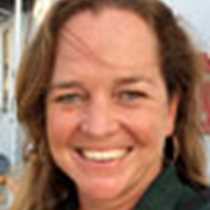Santa Cruz and North Seymour Islands
After having lifted anchor in the small hours of the morning, the Islander sailed approximately 40 nautical miles over night from James Bay on Santiago Island back to the beautiful Santa Cruz.
Santa Cruz is the second largest island in the Galápagos Archipelago, and is one of the “middle-aged” islands, along with Santiago, aged at about 1.7 million years. We have now explored this island quite thoroughly, starting by crossing it from north to south and through four of its seven vegetation zones on our arrival, day before yesterday. During this crossing, we stopped off to explore rare remnants of the unique Scalesia cloud forests, draped with epiphytes and home to myriad Darwin’s finches. We gazed at immense sunken craters and then walked through pastures searching for the Santa Cruz giant tortoise, of which the island boasts a healthy population. We descended into the town of Puerto Ayora, the largest human settlement in Galápagos, also on Santa Cruz, where we first boarded our home for the next week.
Now, two days later, we find ourselves in the pristine north western side of the island, where we disembarked in an area named “Dragon Hill” to look for yet another endemic Galápagos reptile, the elusive land iguana. Although an endangered species that has been the aim of an intensive breeding and repatriation program, today they were everywhere to be seen, both by those who took our Zodiac cruises and those who took our nature hikes. We couldn’t help contrasting, in our minds, the forest of giant Opuntia cacti we were strolling through today with the Scalesia cloud forests of the other day, and marvelling that one island can house such opposite ecosystems, both unique in their way.
We left my home island (I became bewitched by Santa Cruz about nine years ago!) behind later this morning, and set our sights to the small but highly biodiverse islet of North Seymour. On the way we circumnavigated a famous tuff cone named Daphne Major, the site of important research by a British couple of scientists, Peter and Rosemary Grant, into natural selection among the Darwin finches; after which we feasted on a spectacular traditional Ecuadorian buffet prepared for us by our hotel staff.
The afternoon was just as full, as we donned our masks and snorkels to explore the waters bathing the shores of North Seymour from Zodiacs, swimming among tropical reef fish, sharks and rays. Those who still had some energy left then took a beautiful walk on the island, among endemic seabirds (including the endemic swallow-tailed gull – the only nocturnal gull in the world), sea lions and a record-breaking number of land iguanas; before returning to the ship to relive our experiences over recap, cocktail in hand.
After having lifted anchor in the small hours of the morning, the Islander sailed approximately 40 nautical miles over night from James Bay on Santiago Island back to the beautiful Santa Cruz.
Santa Cruz is the second largest island in the Galápagos Archipelago, and is one of the “middle-aged” islands, along with Santiago, aged at about 1.7 million years. We have now explored this island quite thoroughly, starting by crossing it from north to south and through four of its seven vegetation zones on our arrival, day before yesterday. During this crossing, we stopped off to explore rare remnants of the unique Scalesia cloud forests, draped with epiphytes and home to myriad Darwin’s finches. We gazed at immense sunken craters and then walked through pastures searching for the Santa Cruz giant tortoise, of which the island boasts a healthy population. We descended into the town of Puerto Ayora, the largest human settlement in Galápagos, also on Santa Cruz, where we first boarded our home for the next week.
Now, two days later, we find ourselves in the pristine north western side of the island, where we disembarked in an area named “Dragon Hill” to look for yet another endemic Galápagos reptile, the elusive land iguana. Although an endangered species that has been the aim of an intensive breeding and repatriation program, today they were everywhere to be seen, both by those who took our Zodiac cruises and those who took our nature hikes. We couldn’t help contrasting, in our minds, the forest of giant Opuntia cacti we were strolling through today with the Scalesia cloud forests of the other day, and marvelling that one island can house such opposite ecosystems, both unique in their way.
We left my home island (I became bewitched by Santa Cruz about nine years ago!) behind later this morning, and set our sights to the small but highly biodiverse islet of North Seymour. On the way we circumnavigated a famous tuff cone named Daphne Major, the site of important research by a British couple of scientists, Peter and Rosemary Grant, into natural selection among the Darwin finches; after which we feasted on a spectacular traditional Ecuadorian buffet prepared for us by our hotel staff.
The afternoon was just as full, as we donned our masks and snorkels to explore the waters bathing the shores of North Seymour from Zodiacs, swimming among tropical reef fish, sharks and rays. Those who still had some energy left then took a beautiful walk on the island, among endemic seabirds (including the endemic swallow-tailed gull – the only nocturnal gull in the world), sea lions and a record-breaking number of land iguanas; before returning to the ship to relive our experiences over recap, cocktail in hand.




